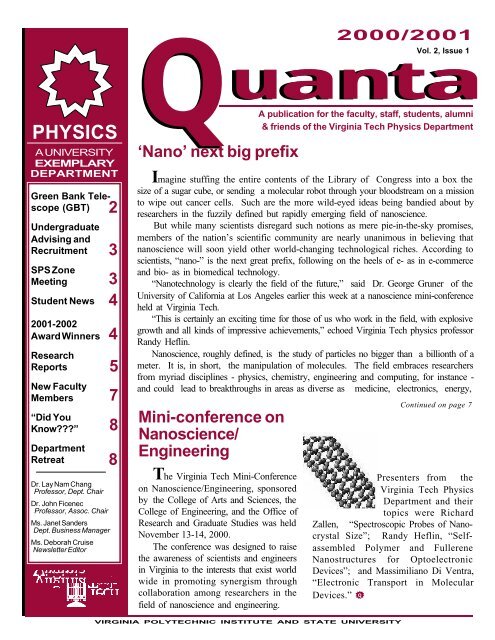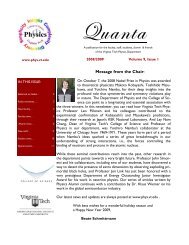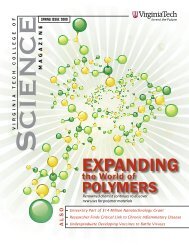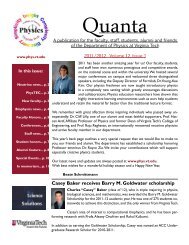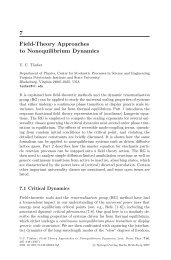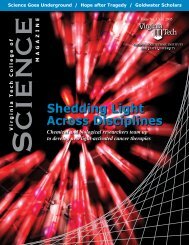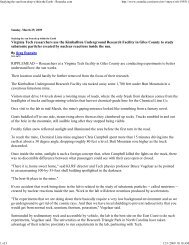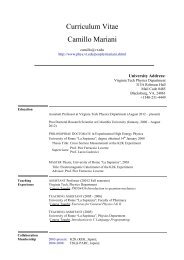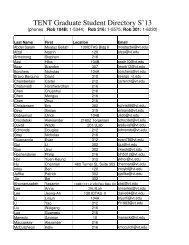Spring 2001 - Physics - Virginia Tech
Spring 2001 - Physics - Virginia Tech
Spring 2001 - Physics - Virginia Tech
Create successful ePaper yourself
Turn your PDF publications into a flip-book with our unique Google optimized e-Paper software.
PHYSICS<br />
A UNIVERSITY<br />
EXEMPLARY<br />
DEPARTMENT<br />
Green Bank Telescope<br />
(GBT)<br />
Undergraduate<br />
Advising and<br />
Recruitment<br />
SPS Zone<br />
Meeting<br />
Student News<br />
<strong>2001</strong>-2002<br />
Award Winners<br />
Research<br />
Reports<br />
New Faculty<br />
Members<br />
“Did You<br />
Know???”<br />
Department<br />
Retreat<br />
Dr. Lay Nam Chang<br />
Professor, Dept. Chair<br />
Dr. John Ficenec<br />
Professor, Assoc. Chair<br />
Ms. Janet Sanders<br />
Dept. Business Manager<br />
Ms. Deborah Cruise<br />
Newsletter Editor<br />
2<br />
3<br />
3<br />
4<br />
4<br />
5<br />
7<br />
8<br />
8<br />
Q<br />
2000/<strong>2001</strong><br />
Vol. 2, Issue 1<br />
uanta<br />
A publication for the faculty, staff, students, alumni<br />
& friends of the <strong>Virginia</strong> <strong>Tech</strong> <strong>Physics</strong> Department<br />
‘Nano’ next big prefix<br />
Mini-conference on<br />
Nanoscience/<br />
Engineering<br />
The <strong>Virginia</strong> <strong>Tech</strong> Mini-Conference<br />
on Nanoscience/Engineering, sponsored<br />
by the College of Arts and Sciences, the<br />
College of Engineering, and the Office of<br />
Research and Graduate Studies was held<br />
November 13-14, 2000.<br />
The conference was designed to raise<br />
the awareness of scientists and engineers<br />
in <strong>Virginia</strong> to the interests that exist world<br />
wide in promoting synergism through<br />
collaboration among researchers in the<br />
field of nanoscience and engineering.<br />
uanta<br />
Imagine stuffing the entire contents of the Library of Congress into a box the<br />
size of a sugar cube, or sending a molecular robot through your bloodstream on a mission<br />
to wipe out cancer cells. Such are the more wild-eyed ideas being bandied about by<br />
researchers in the fuzzily defined but rapidly emerging field of nanoscience.<br />
But while many scientists disregard such notions as mere pie-in-the-sky promises,<br />
members of the nation’s scientific community are nearly unanimous in believing that<br />
nanoscience will soon yield other world-changing technological riches. According to<br />
scientists, “nano-” is the next great prefix, following on the heels of e- as in e-commerce<br />
and bio- as in biomedical technology.<br />
“Nanotechnology is clearly the field of the future,” said Dr. George Gruner of the<br />
University of California at Los Angeles earlier this week at a nanoscience mini-conference<br />
held at <strong>Virginia</strong> <strong>Tech</strong>.<br />
“This is certainly an exciting time for those of us who work in the field, with explosive<br />
growth and all kinds of impressive achievements,” echoed <strong>Virginia</strong> <strong>Tech</strong> physics professor<br />
Randy Heflin.<br />
Nanoscience, roughly defined, is the study of particles no bigger than a billionth of a<br />
meter. It is, in short, the manipulation of molecules. The field embraces researchers<br />
from myriad disciplines - physics, chemistry, engineering and computing, for instance -<br />
and could lead to breakthroughs in areas as diverse as medicine, electronics, energy,<br />
Continued on page 7<br />
Presenters from the<br />
<strong>Virginia</strong> <strong>Tech</strong> <strong>Physics</strong><br />
Department and their<br />
topics were Richard<br />
Zallen, “Spectroscopic Probes of Nanocrystal<br />
Size”; Randy Heflin, “Selfassembled<br />
Polymer and Fullerene<br />
Nanostructures for Optoelectronic<br />
Devices”; and Massimiliano Di Ventra,<br />
“Electronic Transport in Molecular<br />
Devices.” Q<br />
VIRGINIA POLYTECHNIC INSTITUTE AND STATE UNIVERSITY
2<br />
The Green Bank Telescope<br />
by John Broderick<br />
GBT DISH - photo credits to NRAO/AUI<br />
On a sunny day last August 28th hundreds of<br />
people gathered at the National Radio Astronomy Observatory<br />
at Green Bank, West <strong>Virginia</strong> to dedicate the Robert<br />
C. Byrd Green Bank Telescope (hereafter called by its<br />
affectionate nickname, the GBT). Sen. Byrd gave the<br />
keynote address at the dedication, preceded by remarks<br />
from the heads of NASA and the NSF. At the beginning of<br />
the dedication ceremony a rhythmic drumming noise could<br />
be heard — like someone beating a drum but not very<br />
musically. It turned out to be an<br />
audio display of a pulsar that the<br />
telescope was tracking. This was<br />
the same pulsar that had been observed<br />
during the “first light”<br />
observations for the telescope two<br />
nights earlier. This dedication ceremony<br />
culminated a 12-year quest<br />
for a new, state-of-the-art radio<br />
telescope to replace the one I broke<br />
(by accident) in November 1988.<br />
I didn’t really break the old<br />
300-foot telescope but an observing<br />
program of mine (along with two<br />
NRAO scientists) was running at<br />
the time of its demise. People have<br />
kidded me about breaking the 300-<br />
foot, and I tell them I’m proud to claim it. Proud because<br />
its collapse led to the replacement of a telescope built in<br />
1962 costing $800,000, as a stopgap instrument to be used<br />
only until the 140-foot telescope construction was<br />
completed. This replacement telescope (the GBT) cost<br />
more than $75-million. Although its aperture is not<br />
significantly larger than the 300 foot (101 meters versus<br />
92 meters), its new features are well worth the increased<br />
replacement cost — like wrecking an old Corvair and<br />
getting it replaced by a new Corvette.<br />
The GBT will be able to observe at wavelengths<br />
shorter than 3 mm, whereas the 300-foot had trouble even<br />
with 6-cm wavelengths. (A good telescope has a reflecting<br />
surface at least16 times smoother than the observing<br />
wavelength; thus shorter wavelengths require more accur-<br />
ate surfaces.) The surface of the GBT can be kept accurate<br />
to such small tolerances by actuators that adjust the 2004<br />
panels making up the surface, overcoming surface deformations<br />
caused by temperature, wind and gravity. Short<br />
wavelength capability is important because many molecules<br />
produce spectral lines in the millimeter-wavelength end of<br />
the radio band. Carbon monoxide (CO) is one of the most<br />
important of these molecules. CO shines brightly at a<br />
wavelength of 2.6 mm and is an effective tracer of the<br />
molecular hydrogen gas that makes up giant molecular<br />
clouds -- sites of star formation that can be up to a million<br />
times more massive than the sun. Molecular hydrogen is<br />
the most abundant molecule in the universe but is nearly<br />
invisible even though it is a hundred<br />
thousand times more abundant than<br />
CO. CO is so bright that it has been<br />
detected in quasars off on the other<br />
side of the universe. The GBT will<br />
be able to detect CO in many distant<br />
galaxies, helping us to better<br />
understand star formation in young<br />
galaxies, which themselves are still<br />
in the process of formation. We see<br />
these galaxies as they were long ago<br />
while still in their formation stage<br />
because their light has taken so long<br />
to get here.<br />
The GBT is fully steerable<br />
whereas the 300-foot was a meridian<br />
transit telescope; meaning that it<br />
could only look at the part of the sky which was transiting<br />
the meridian (the north-south line). Although the 300-foot<br />
could see any part of the sky above the southern horizon, it<br />
could only do so while that part transited the meridian. A<br />
weak source might not be detectable because of the short<br />
duration of the observation. The GBT will be able to track<br />
a radio source from horizon to horizon, if need be, to achieve<br />
the low noise levels necessary for detecting weak radio<br />
features.<br />
An important new design feature of the telescope is<br />
its unblocked aperture; this is what makes it look so funny:<br />
like a giant erector-set big-bird. Signals from the sky are<br />
reflected to a focus placed off to the side of the dish, where<br />
they are collected, amplified and sent to the control room<br />
to be recorded and analyzed. As seen from the radio source<br />
the dish of the GBT has no obstructions in its wave path.<br />
Usually radio telescope “feeds” (the things that collect the<br />
incoming radio waves at the focal point) are placed directly<br />
VIRGINIA POLYTECHNIC INSTITUTE AND STATE UNIVERSITY<br />
Continued on page 4
Undergraduate Academic<br />
Advisor and Recruitment<br />
(SPS) Hosts Zone Meeting<br />
by Jerome Long<br />
3<br />
Diane Walker-Green joined the<br />
<strong>Physics</strong> Department in February 2000, as<br />
the department undergraduate student advisor<br />
and recruitor. Diane has not only<br />
been an asset to the department, but to our<br />
current undergraduates as well. She has<br />
an excellent working relationship with the<br />
students and they come to her often for guidance. Join us<br />
in welcoming Diane as a member of our staff.<br />
A personal statement: by Diane Walker-Green<br />
I’ve had a very busy and exciting year. I’ve focused<br />
the recruiting portion of my duties on high school physics<br />
classes. In the past year I’ve visited 22 high schools, talking<br />
to physics, biology and chemistry students. My presentations<br />
include a suggestive list of high school courses<br />
that prepare a student to be strong in physics, combined<br />
with a little Hokie trivia, admissions information, and a<br />
heart to heart discussion on independence, maturing, and<br />
freedom that a student experiences when they first arrive<br />
on campus. I have also begun to build a working relationship<br />
with high schools that our current physics majors once<br />
attended. As a follow-up, each teacher receives a thank<br />
you note with a complimentary <strong>Virginia</strong> <strong>Tech</strong> promotional<br />
item, periodic updates on undergraduate information about<br />
the physics department and the departmental newsletter.<br />
Even though I love to travel and meet prospective students,<br />
I have to admit that the part of my job I enjoy most is<br />
academic advising. As an advisor I follow the student’s<br />
progress, as well as their course of study, and get to know<br />
them as a person. I not only get to talk with our students,<br />
but I listen to what they have to say. I encourage students<br />
to maintain an open line of communication. I sometimes<br />
serve as a liaison between faculty and students. When faculty<br />
members ask about a student for various reasons, I’m<br />
usually able to give them a little background information,<br />
as well as a progress report without ever pulling the students<br />
record.<br />
My goals for the upcoming year are: 1) an undergraduate<br />
summer research program; 2) a summer camp for high<br />
school students; 3) establish a tutorial program that will be<br />
free for students who need tutoring; and 4) advanced placement<br />
certification workshop for high school teachers.<br />
In closing, I’d like to thank the students, staff and faculty<br />
for their support, encouragement and suggestions. Your<br />
assistance has made my job very enjoyable. Q<br />
Representatives of SPS chapters in Zone 4 of<br />
the Society of <strong>Physics</strong> Students came to Blacksburg for a<br />
Zone Meeting on October 14, 2000. After Saturday morning<br />
coffee and doughnuts, the meeting opened with a keynote<br />
lecture on the Theory of Strings by <strong>Virginia</strong> <strong>Tech</strong> <strong>Physics</strong><br />
Chairman Dr. Lay Nam Chang. The morning session of the<br />
meeting included short presentations of the results of<br />
undergraduate research participation. The afternoon session<br />
featured a tour of departmental laboratories and a panel of<br />
three <strong>Virginia</strong> <strong>Tech</strong> <strong>Physics</strong> alumni who have gone on to<br />
diverse and successful careers. The meeting concluded with<br />
a pizza party and informal conversation.<br />
The Society of <strong>Physics</strong> Students is an affiliate of the<br />
American Institute of <strong>Physics</strong> and manages a membership<br />
of some 6,000 physics students in over 650 chapters on<br />
campuses throughout North America. Each chapter belongs<br />
to one of 18 zones with some 25 to 45 chapters in each<br />
zone. The chapters from a zone attempt to hold one or two<br />
zone meetings each year. The 40 plus chapters of Zone 4<br />
are those from the colleges and universities of Maryland,<br />
<strong>Virginia</strong> and the District of Columbia. Zone meetings and<br />
other affairs within a zone are coordinated by an elected<br />
Zone Councilor. The current Zone 4 Councilor is Dr. Jerome<br />
R. Long , Chapter Advisor for <strong>Virginia</strong> <strong>Tech</strong>. The <strong>Virginia</strong><br />
<strong>Tech</strong> chapter, with an active program and one of the largest<br />
national memberships, has been one of the 5% of chapters<br />
consistently designated as outstanding by the national<br />
organization. Individuals and groups within the chapter<br />
have won numerous awards and other national recognition.<br />
Due to the large travel time between chapters of Eastern<br />
Maryland and those of Western <strong>Virginia</strong>, Zone 4 attempts<br />
to have two annual meetings with a western meeting in the<br />
Fall and an eastern meeting in the <strong>Spring</strong>. Despite that long<br />
distance, the October 14 western meeting in Blacksburg<br />
drew attendees from Maryland’s Towson University and<br />
tidewater <strong>Virginia</strong>’s Hampton University. The Saturday<br />
morning session of student presentations included two<br />
contributions from each of those institutions. As one might<br />
expect, several students from the <strong>Virginia</strong> <strong>Tech</strong> chapter<br />
made presentations. The <strong>Spring</strong> meeting for Zone 4 was<br />
held at Towson University on March 31, <strong>2001</strong>, and included<br />
participants from <strong>Virginia</strong> <strong>Tech</strong>.<br />
Perhaps the most unusual of the features of the October<br />
14 meeting was the panel of alumni on Saturday afternoon.<br />
The three alumni panelists were Ms. Noel Heiks (‘92),<br />
Mr. Robin Clark, Esq. (‘94) and Mr. Eric Carlson (‘95).<br />
Each panelist gave a short presentation of the nature of<br />
VIRGINIA POLYTECHNIC INSTITUTE AND STATE UNIVERSITY<br />
Continued on page 8
4<br />
<strong>2001</strong>-2002 Award Winners<br />
Alice Estes Martin<br />
Scholarship<br />
Alma Robinson<br />
Col. Nelson Carey Brown<br />
Memorial Scholarship<br />
Jennifer Beard<br />
Daniel C. & Delia F. Grant<br />
Endowed Scholarship<br />
Anubav Vasudevan<br />
Jerome Mettetal<br />
Frank Leigh Robeson<br />
Scholarship<br />
James Roberts, Seth Smith<br />
H.Y. Loh Award<br />
Josh King<br />
Hugh D. Ussery<br />
Scholarship<br />
Larry Cook<br />
Robert C. Richardson<br />
Scholarship<br />
Rafael Hipilito<br />
Robert P. Hamilton Prize<br />
Beth Reid<br />
Theodore E. Leinhardt<br />
Scholarship<br />
Zachary Lewis<br />
Webster & Sara Schoene<br />
Richardson Memorial<br />
Scholarship<br />
Christopher Graziul<br />
C.H. Wan Scholarship<br />
Anubav Vasudevan<br />
Ray F. Tipsword Graduate<br />
Scholarship<br />
Robert J. Astalos<br />
Jamie Dunn Award<br />
Thomas J. Bullard<br />
The Green Bank Telescope<br />
Continued from page 2<br />
in front of the dish. The feeds are held<br />
there by feed-support legs that make<br />
the dish, as seen from the radio source,<br />
appear to be blocked by an X-shaped<br />
obstruction. Although this obstruction<br />
doesn’t remove much signal (the<br />
blocking area of the feed-support legs<br />
is much smaller than the total area of<br />
the dish), what happens is that signals<br />
from other directions<br />
of the sky<br />
can scatter, reflect<br />
or diffract into the<br />
feeds and contaminate<br />
the observation.<br />
The detected<br />
signal<br />
comes not just<br />
from the direction<br />
in which the<br />
telescope is pointing<br />
but also from<br />
other points in the<br />
GBT STRUCTUREphoto<br />
credits to<br />
NRAO/AUI<br />
sky. These contaminating signals,<br />
called sidelobes, form a four-point<br />
star, a familiar sight in astronomical<br />
photographs. Sidelobes aren’t too<br />
much of a problem for optical<br />
astronomy, but they can be particularly<br />
troublesome when mapping the<br />
wide-scale distribution of spectralline-emitting<br />
gas like neutral hydrogen.<br />
Strong signals from a cloud of gas in a<br />
nearby part of the sky can get scattered<br />
into the feed and overwhelm the weak<br />
signal coming from the location being<br />
observed. The GBT will not have<br />
this problem. Another useful property<br />
of an unblocked aperture is the absence<br />
of standing waves, which contaminate<br />
the baseline of spectral-line<br />
observations. These standing waves,<br />
which are amplified by multiple<br />
reflections between the dish and the<br />
feed, produce a wavy baseline in the<br />
plot of line strength versus observing<br />
frequency. The peaks and troughs of<br />
this undulating baseline can mask the<br />
presence of weak, broadened spectral<br />
lines. Because multiple reflections do<br />
not occur with an off-axis focus, the<br />
problem is neatly avoided.<br />
Currently the NRAO is accepting<br />
“Early Science” proposals while the<br />
testing of the telescope and the installation<br />
of new receivers proceed. Longer<br />
wavelength observations will get the<br />
first crack at the telescope. Once the<br />
complicated servo-system needed to<br />
maintain the high surface accuracy is<br />
working, the usable wave-lengths will<br />
begin to shrink. Our own Prof. Brian<br />
Dennison will be among these early<br />
users. He will collaborate with NRAO<br />
scientists (including <strong>Physics</strong> Department<br />
alumnus, Toney Minter) to try to<br />
make the first detection of a very broad<br />
fine-structure line of atomic hydrogen.<br />
Without the flat baseline capability of<br />
the GBT this project could not be done.<br />
<strong>Tech</strong> astronomers have always had<br />
a close connection with this nearby<br />
observatory, and with the GBT on line<br />
this connection will continue and<br />
perhaps even grow closer. Q<br />
Student News<br />
Graduate student, Mark F.<br />
Makela, Department of <strong>Physics</strong> was selected<br />
to attend the 51st Meeting of<br />
Nobel Laureates. Mark is currently<br />
working with Prof. Bruce Vogelaar.<br />
Congratulations, Mark! Q<br />
VIRGINIA POLYTECHNIC INSTITUTE AND STATE UNIVERSITY
<strong>Physics</strong> Research Reports<br />
New and on-going initiatives<br />
Theoretical physicist shows single molecule can be transistor<br />
5<br />
The problem: Smaller, more<br />
powerful microprocessors require<br />
squeezing more transistors into a<br />
single chip—but there’s a limit.<br />
Transistors switch current on and<br />
off and amplify current. In existing<br />
transistors, this is done by applying<br />
voltage to a gate electrode between<br />
the input (source) and output<br />
(drain) electrodes. More transistors<br />
in a single chip means more<br />
computational speed. Presently, a<br />
single chip can hold up to about 50<br />
million transistors, but leakage and<br />
tunneling are already a problem.<br />
Stray current (leakage) causes<br />
crossed signals, and electrons bypassing<br />
gate fields (tunneling)<br />
prevents current amplification.<br />
The solution may be molecular<br />
electronics. “We can use molecules<br />
as transistors, switches, and memory<br />
devices,” said Massimiliano Di<br />
Ventra, who joined the physics faculty<br />
at <strong>Virginia</strong> <strong>Tech</strong> this summer.<br />
“We want to integrate billions of<br />
molecules into a single chip,” he said.<br />
“We will have this technology<br />
probably in 15 to 20 years.”<br />
Di Ventra is a theoretical physicist<br />
whose research focus is to<br />
understand<br />
how molecular electronic devices<br />
work. He studies how a specific<br />
molecule will behave under current<br />
flow. “I inject current into the<br />
molecule to see if it can work like a<br />
transistor, a switching device, and the<br />
like.” Last spring, he demonstrated<br />
that a benzene molecule can work<br />
as a transistor (published in the June<br />
5, 2000 issue of Applied <strong>Physics</strong><br />
Letters), acting not only as a switch<br />
but also as an amplifier.<br />
Nature columnist Philip Ball<br />
hailed the work in a “Science Update”<br />
article titled “Painless Gain” (Nature, June<br />
2, 2000).<br />
Benzene molecule as transistor<br />
The transistor ’s role as an amplifier is<br />
critical to ensure that signals remain strong<br />
as they pass from place to place. “So far,<br />
obtaining gain from a single-molecule<br />
device has been a big stumbling block for<br />
molecular electronics,” Ball wrote. “Now<br />
Massimiliano Di Ventra …and his<br />
colleagues have shown that this hurdle is,<br />
in principle at least, surmountable.”<br />
Benzene is a common molecule made<br />
up of six carbon atoms forming a hexagon<br />
on a plane. It is abundant and cheap to<br />
manufacture. Di Ventra, Sokrates<br />
Patelides, a colleague in physics and<br />
astronomy at Vanderbilt University, and<br />
Norton Lang of the IBM Research Division<br />
in New York, did a computer simulation of<br />
a benzene molecule between two<br />
electrodes (the source and the drain) and<br />
applied an electric field perpendicular to<br />
the molecule (the gate field).<br />
In the theoretical simulation with the<br />
benzene ring molecule, the drain and<br />
source are two gold electrodes connected<br />
to the benzene molecule by sulfur atoms.<br />
The gate consists of two charged metal<br />
disks above and below the molecule<br />
and between the electrodes. The<br />
electrons flow from source to drain,but<br />
the gate field can be adjusted to control<br />
the electron flow.<br />
For some voltage at the gate field<br />
an “electronic bridge” is formed<br />
between source and drain and electrons<br />
can tunnel across the molecule easily,<br />
allowing a large current flow. This<br />
electronic bridge is called “resonanttunneling.”<br />
Thus, the molecule acts as<br />
a switch, and the signal is amplified by<br />
the gate as in conventional field-effect<br />
transistors.<br />
“Now, tunneling destroys chips if<br />
they are too crowded, but, with<br />
molecules we can use the phenomenon<br />
to our advantage,” Di Ventra said. “We<br />
demonstrated that single molecules can<br />
do the same job as transistors. But these<br />
single elements need to be combined to<br />
form molecular chips. This is a major<br />
technological problem. It is like in the<br />
1940’s when the transistor was invented:<br />
It took 25 years before transistors could<br />
be put together in integrated circuits.”<br />
“The next step in molecular<br />
electronics is to develop molecular chips<br />
that will replace the ones we use in our<br />
computers,” he said. Q<br />
Thanks to Susan Trulove of the<br />
Spectrum for the contribution of this<br />
article.<br />
next<br />
page<br />
VIRGINIA POLYTECHNIC INSTITUTE AND STATE UNIVERSITY
6<br />
<strong>Physics</strong> Research Reports<br />
Continued from page 5<br />
Carilion Biomedical Institute’s Optical Sciences<br />
and Engineering Research (OSER) Center<br />
Prof. Royce Zia<br />
“Scientist in Residence”<br />
Bill Spillman joined <strong>Virginia</strong><br />
<strong>Tech</strong> in 1999 to be the Director of the<br />
Carilion Biomedical Institute's Optical<br />
Sciences and<br />
Engineering Research<br />
(OSER)<br />
Center. Prior to that,<br />
he was Director of<br />
Research and Chief<br />
Scientist at the BF<br />
Goodrich Aircraft<br />
Integrated Systems<br />
Division.<br />
Just before coming to <strong>Tech</strong>, Bill<br />
spent 2 years working on so-called<br />
"smart" biomedical implants. He received<br />
his Ph.D. in experimental condensed<br />
matter physics in 1977 from<br />
Northeastern University in Boston and<br />
joined the physics department last year<br />
as an associate professor. He taught<br />
the Introduction to Biophysics course<br />
last fall and will be teaching it again<br />
in the fall of <strong>2001</strong>.<br />
His current research interests lie<br />
in biophysics and include smart biomedical<br />
implants, automated evolutionary<br />
system design, adaptive computational<br />
techniques, hyperspectral<br />
image processing using cellular automata,<br />
and complex adaptive systems.<br />
He is presently investigating the possibility<br />
of modeling the electro-static<br />
self-assembly process used in<br />
nanofabrication through the use of artificial<br />
life concepts. Bill is a fellow<br />
of the SPIE and last month was elected<br />
a Fellow and Charter Physicist of the<br />
Institute of <strong>Physics</strong> in the U.K. This<br />
June he will be chairing an SPIE conference<br />
on Complex Adaptive Structures.<br />
The OSER Center which Bill directs<br />
was created from a partnership between<br />
the Carilion Health System, <strong>Tech</strong> and the<br />
University of <strong>Virginia</strong>. It has 3 goals:<br />
(1) to improve the research standing in<br />
the biomedical area of the partner universities,<br />
(2) to improve the health care<br />
of the region and the world, and (3) to<br />
create economic development in this region.<br />
OSER currently solicits and<br />
awards grants throughout the university<br />
of approximately $750K/year based on<br />
a call for proposals posted on the center<br />
website (www.OSER.vt.edu).<br />
One of Bill's particular interests is<br />
to foster the development of a strong research<br />
base in biophysics at <strong>Tech</strong>. Biophysics<br />
is a new but rapidly growing interdisciplinary<br />
field where the mathematical<br />
rigor and physical insights of<br />
physics are applied to the complex adaptive<br />
systems of the living world.<br />
Bioinformatics is only one example<br />
of such activity. Bill would be happy<br />
to speak with anyone wishing to<br />
learn in more detail about OSER<br />
and its programs, as well as opportunities<br />
for support and research<br />
(wspillma@vt.edu). Q<br />
Biophysics is a new<br />
but rapidly growing interdisciplinary<br />
field where the<br />
mathematical rigor and<br />
physical insights of physics<br />
are applied to complex<br />
systems of the<br />
living world.<br />
At the invitation by Prof. Hans-<br />
Werner Diehl of the University of Essen<br />
(Germany) ,<br />
Prof. Royce Zia spent 5 months (July-<br />
December, 2000) there as a “Scientist<br />
in Residence.” With no specific duties,<br />
he was able to devote all of his time to<br />
research on statistical mechanics,<br />
especially for systems in nonequilibrium<br />
steady states. In addition<br />
to research and writing, he was able to<br />
travel around Europe, giving seminars/<br />
colloquia. His trip began with lecturing<br />
at the Eotvos School and Workshop on<br />
Phase Separation in <strong>Physics</strong>,<br />
Chemistry, and Biology . Held<br />
at the Eotvos University (Budapest,<br />
Hungary), this combination of school<br />
and workshop is designed for advanced<br />
graduate students and postdoctoral<br />
research associates, focusing on the<br />
subject of pattern formation in a wide<br />
range of areas. Thereafter, Prof. Zia was<br />
based mainly in Essen, but, took this<br />
opportunity to visit his many friends<br />
and collaborators in a dozen institutions<br />
around Germany, Belgium, Denmark,<br />
England, and Holland. Q<br />
VIRGINIA POLYTECHNIC INSTITUTE AND STATE UNIVERSITY
7<br />
‘Nano’<br />
Continued from page 1<br />
biotechnology, information technology,<br />
environmental science and<br />
agriculture.<br />
To understand the different<br />
potentials of tweaking molecules,<br />
consider that Lucent <strong>Tech</strong>nologies and<br />
Oxford University have used nanoscience<br />
to create a tiny pair of<br />
tweezers composed completely of<br />
DNA strands, while Motorola<br />
Corp. is trying to find a way<br />
to use carbon nanotubes -<br />
sheets of carbon molecules<br />
rolled up the way you might roll<br />
up a newspaper - to create a better<br />
computer display screen.<br />
Other scientists are working to turn<br />
a single molecule into an electric<br />
circuit, and some scientists are<br />
pondering ways atoms can be<br />
manipulated to one day create a<br />
“quantum computer” that can solve in<br />
one year problems that would take<br />
today’s best computers billions of<br />
years to figure out.<br />
So important is the nanoscience<br />
field that President Clinton announced<br />
a National Nanotechnology Initiative<br />
earlier this year and proposed $500<br />
million in funding. [editors note:<br />
Initiative announced early 2000].<br />
Research universities across the<br />
country, eyeing the federal funding,<br />
have intensified their work on nanotechnology<br />
and have begun offering<br />
more nano-related classes. <strong>Virginia</strong><br />
<strong>Tech</strong>, looking to move ahead of other<br />
institutions, is considering the creation<br />
of an interdisciplinary Center for Self-<br />
Assembled Nanostructures and<br />
Devices.<br />
The promises of nanoscience are<br />
only a few years away, said Stephen<br />
Turner, a physics professor at Cornell<br />
who spoke at <strong>Virginia</strong> <strong>Tech</strong>’s<br />
nanoscience mini-conference. “We’re<br />
trying to do things that are going to be<br />
used three or four years from now.”<br />
Alex Zettl, physics professor at the<br />
University of California at Berkeley,<br />
said research there on carbon<br />
nanotubes has yielded ways to build<br />
nanosprings, nano-bearings and<br />
nanoelectric switches, potentially<br />
useful if molecular engines and<br />
robots become reality.<br />
Scientists say there are<br />
still problems to overcome<br />
and questions to answer,<br />
but the research conducted<br />
so far promises that<br />
manipulating molecules will produce<br />
incredible technological advances.<br />
As Zettl said of his nanotube<br />
research: “It turns out all these things<br />
are working out better than we had a<br />
right to expect.” Q<br />
“Copyright Richmond Times-<br />
Dispatch, used with permission.”<br />
“We’re trying to<br />
do things that are<br />
going to be used three<br />
or four years from now.”<br />
- Dr. Stephen Turner<br />
New Faculty Members<br />
Massimiliano Di Ventra - Massimiliano Di Ventra<br />
obtained his BS degree in <strong>Physics</strong> magna cum<br />
laude from the University of Trieste, Italy, in 1991<br />
and his PhD in <strong>Physics</strong> from the Ecole<br />
Polytechnique Federale of Lausanne, Switzerland<br />
in 1997. The same year he moved to<br />
Vanderbilt University as Research Associate and<br />
in 1999 he became Research Assistant Professor<br />
in the same University. Since 1998 he has<br />
been Visiting Scientist at IBM T.J. Watson Research<br />
Center. In summer 2000 he was appointed<br />
Assistant Professor of <strong>Physics</strong> at <strong>Virginia</strong> <strong>Tech</strong>.<br />
His research focus is in first-principles atomistic<br />
simulations of electronic, optical, and transport<br />
properties of materials with special emphasis on<br />
wide-bandgap materials, biological systems and<br />
devices for Molecular Electronics applications.<br />
His work in molecular electronics has been featured<br />
twice in the journal Nature and other national<br />
and international journals. He has been invited<br />
to give more than thirty presentations at conferences,<br />
workshops and seminars at universities,<br />
national and industrial laboratories worldwide. He<br />
has also filed a patent on a novel processing for<br />
power-electronics applications.<br />
Caren Hagner - Caren Hagner obtained her<br />
PhD in <strong>Physics</strong> from the “<strong>Tech</strong>nische Universit ät<br />
München” (TUM), Germany in 1995 were she<br />
participated in an experiment searching for neutrino<br />
decays at a nuclear power reactor in Bugey<br />
(France). She was awarded the prize for best<br />
thesis of the year at TUM. She then received a<br />
Marie-Curie Fellowship and was Research Associate<br />
at the “Commisariat à l’Énergie<br />
Atomique” in Saclay (France), where she participated<br />
in the NOMAD neutrino oscillation experiment<br />
at CERN (Geneva, Switzerland). In<br />
1997 she joined the BOREXINO group, a solar<br />
neutrino experiment at the Gran Sasso Underground<br />
Laboratory in Italy, at the “<strong>Tech</strong>nische<br />
Universität München” as Research Associate.<br />
She was a member of the Astroparticle <strong>Physics</strong><br />
Center in Munich focusing on Dark Matter Search.<br />
In January <strong>2001</strong> she moved to <strong>Virginia</strong> <strong>Tech</strong><br />
where she was appointed Assistant Professor. Her<br />
work in experimental particle physics has been<br />
focused on Neutrino <strong>Physics</strong>. It covers a large<br />
variety of detection techniques (from wire chambers<br />
to ultra-low radioactivity liquid scintillator detectors)<br />
and neutrino energies (low energy reactor<br />
neutrinos, solar neutrinos, supernova neutrinos<br />
and high energy neutrinos from accelerators).<br />
At <strong>Virginia</strong> <strong>Tech</strong> she will join the group of the<br />
BELLE experiment at KEK(Japan) where B-<br />
<strong>Physics</strong> and CP-Violation are studied.<br />
VIRGINIA POLYTECHNIC INSTITUTE AND STATE UNIVERSITY
8<br />
<strong>Physics</strong> Department Retreat<br />
by John Ficenec<br />
The department held a retreat on<br />
September 22-23, <strong>2001</strong>, at Mountain<br />
Lake Resort, Mountain Lake, <strong>Virginia</strong>,<br />
with 85% of the faculty in attendance.<br />
The secluded and colorful surroundings<br />
provided an uplifting environment, free<br />
of the usual interruptions on campus. The<br />
retreat format consisted of breakout<br />
sessions with small-group discussions,<br />
followed by group reports and discussions<br />
among all participants.<br />
The first discussion was focused on<br />
long-term research interests and the<br />
number of faculty required to have an<br />
impact in each research area. Initiation<br />
of new re-search directions such as<br />
nano-science, bioscience, and quantum<br />
computing; reconfiguration of current<br />
programs in astrophysics and theoretical<br />
mesoscopic physics; and consolidation<br />
of our base programs in astronomy,<br />
particle physics, and condensed-matter/<br />
optics were discussed. A general consensus<br />
was reached on new faculty hires<br />
for the next several years in order to<br />
position the department with the proper<br />
mix of applied and fundamental research.<br />
The second discussion was focused<br />
on the teaching and outreach mission of<br />
the department. Service courses and the<br />
role of technology in these courses; the<br />
number and types of undergraduate and<br />
and graduate courses to better serve the<br />
needs of BS/BA, MS, and PhD graduates;<br />
retention of undergraduate majors;<br />
and the level of expanded off-campus<br />
course offerings and outreach to serve<br />
the needs of non-traditional students and<br />
the public at large were discussed.<br />
Several suggestions surfaced in these<br />
discussions which are being examined<br />
in more detail with a goal of<br />
implementation.<br />
An opportunity to engage in less<br />
physics-focused conversation was<br />
provided by a cocktail hour, dinner, and<br />
sleep-over for faculty, staff, and their<br />
significant others. The astronomy group<br />
provided the participants with a tour of<br />
the observatory or a keystone-cop film<br />
clip of the CCD-equipped telescope<br />
proposal and construction process. An<br />
enjoyable time was had by all, with a<br />
renewed sense of a commonly-held<br />
Q<br />
direction for the department.<br />
SPS Zone Meeting<br />
Continued from Page 3<br />
their work. The presentations were followed<br />
by open discussion between<br />
panelists and with the audience. Ms.<br />
Heiks is currently Vice President for<br />
Sales and Marketing with HALEOS, Inc.<br />
Robin Clark is a patents attorney with<br />
the firm of Hunton & Williams. Eric<br />
Carlson is a staff scientist at Hy<strong>Tech</strong><br />
Research Corp. The Society of <strong>Physics</strong><br />
Students is very grateful to these persons<br />
for giving of their Saturday time to participate<br />
freely in this exchange.<br />
Q<br />
“DID YOU KNOW??”<br />
There are many different ways<br />
to give to your favorite programs at<br />
<strong>Virginia</strong> <strong>Tech</strong>, including the Department<br />
of <strong>Physics</strong>. Most people know about<br />
making cash donations, but there are other<br />
methods to give that may better suit your<br />
financial situation. You may be surprised<br />
to learn what kinds of gifts<br />
<strong>Virginia</strong> <strong>Tech</strong> accepts, and how you can<br />
avoid some taxes you thought you<br />
would have to pay. For more information<br />
about giving stock, receiving<br />
income in exchange for your gift or<br />
making a donation through your estate<br />
plans, please contact Connie Talbott,<br />
the Director of Development for the<br />
College of Arts & Sciences, or one of<br />
our gift planning professionals at (800)<br />
Q<br />
533-1144.<br />
Article written by Kevin Weekly,<br />
Assoc. Director of Planned Giving,<br />
University Develoment.<br />
<strong>Virginia</strong> <strong>Tech</strong><br />
<strong>Physics</strong> Department<br />
123 Robeson Hall<br />
Blacksburg, VA 24061-0435<br />
U.S. Postage<br />
PAID<br />
Blacksburg, VA 24060<br />
Permit No 28<br />
NON-PROFIT ORG<br />
VIRGINIA POLYTECHNIC INSTITUTE AND STATE UNIVERSITY


